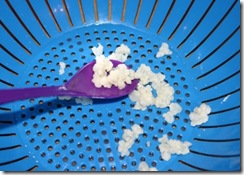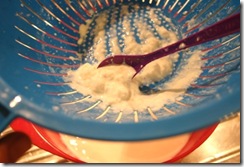 Kefir, a fermented and microbial-rich drink, can be made at home using ‘live kefir grains’ which contain the beneficial yeasts, bacteria and minerals which make this drink so unique. These grains can be used time and time again to ferment organic cows, goat, soy or rice milk or young coconut water into an invigorating tonic.
Kefir, a fermented and microbial-rich drink, can be made at home using ‘live kefir grains’ which contain the beneficial yeasts, bacteria and minerals which make this drink so unique. These grains can be used time and time again to ferment organic cows, goat, soy or rice milk or young coconut water into an invigorating tonic.
Here is a step-by-step guide on how to make kefir using these live grains – as opposed to a powdery starter culture – for a continuous supply of this probiotic liquid. Your intestines and digestive tract will love you for it!
Here is a quick summary of how kefir works to aid your digestion and heal your inner immune system. This is from the book The Body Ecology Diet by Donna Gates (2007, p105):
“Kefir from milk is a complete protein with all the essential amino acids. By the time you drink kefir, its friendly bacteria have already partially digested the protein, making it much easier for you to digest. High amounts of protein are critical to healing, and your body must have adequate minerals in order to assimilate the protein. Kefir provides these, too. Both milk kefir and young coconut kefir contain an abundance of calcium and magnesium.”
For more in-depth information on the health benefits of kefir, I recommend the article The Healing Properties of Kefir.
I have also written a previous post on Making rice milk kefir using a starter culture, whereas this post will focus on using fresh organic cows milk and the kefir grains.
Kefir grains
 First of all you will need to obtain some of the kefir grains, which are small white or yellow gelatinous clumps that look like tiny cauliflower florets or coral. Some organic or health food stores may stock these in their refrigerated dairy sections. I didn’t have such luck in my city, however was able to purchase some online on eBay from a local seller here in Germany.
First of all you will need to obtain some of the kefir grains, which are small white or yellow gelatinous clumps that look like tiny cauliflower florets or coral. Some organic or health food stores may stock these in their refrigerated dairy sections. I didn’t have such luck in my city, however was able to purchase some online on eBay from a local seller here in Germany.
I paid €10 (US$13.05) for enough grains to ferment 800ml of milk. Each tiny packet – about the size of a teaspoon of grains – cost €2.50 and was sufficient for 200ml of milk.
With each fermentation the grains grow slightly in size, so that now after about eight fermentations I have split my grains into two batches, with each able to ferment one litre of milk.
This process means that after a short while your small investment multiplies and you will soon be able to gift some kefir grains to family or friends, increase the amount of milk you ferment at one time (e.g. two litres), or ferment two or more batches simultaneously.
And of course, the cost per litre of kefir decreases with each succeeding fermentation, as the same original grains are reused each time. Considering that I pay €0,89 per litre of organic cows milk, my first 10 batches cost €1,89 per litre, after 20 batches the average cost is €1,39 per litre and by 30 batches €1,22 per litre. In comparison, a 500ml bottle of organic kefir bought from the shop costs €0,99 (€1,98 per litre).
Fermenting cows milk using kefir grains
Begin with enough kefir grains to ferment between 800-1000ml of milk and use fresh organic cows milk. Raw milk is often recommended for its health benefits, however I use the regular pasteurised version found in most shops. Many people find raw milk hard to find without knowing a local farmer.
You will also need a one litre-sized glass jar with a clamp-down lid, a plastic spoon (preferably with a long handle) and a plastic sieve.
1. Firstly, you need to sterilise the glass jar. This can be simply done by boiling half a kettle of water, then pouring the water into the jar and half-closing the lid, allowing steam to escape. Let it sit for five to ten minutes.
2. Pour the milk into a small pot and warm gently on the stove at a low heat. The milk should be heated through, but definitely not to the point of boiling. You can test the temperature by sticking a knuckle in every couple of minutes. Stir often. Note – when using rice or soy milk this step can be omitted.
3. When it is heated, turn the stove off and let stand for a couple of minutes. Empty the glass jar of its hot water and let both the jar and milk cool for 15-20 minutes to room temperature.
 4. Pour the warmed milk into the glass jar. Using a plastic spoon – not metal, as this can damage the bacteria cultures, and gently place the kefir grains in the jar with the milk and stir. If the milk is too hot when you add the kefir grains, this can damage and spoil them.
4. Pour the warmed milk into the glass jar. Using a plastic spoon – not metal, as this can damage the bacteria cultures, and gently place the kefir grains in the jar with the milk and stir. If the milk is too hot when you add the kefir grains, this can damage and spoil them.
5. Close the lid and place in a dark place at room temperature (20-24 degrees Celsius). The fermentation process takes around one to two days.
6. When the kefir is ready, the texture of the milk should have changed into a thicker consistency, it should taste a little bit sour and when the clamp-lid is released, it may make a little ‘pop’ or ‘hiss’ sound.
Sometimes the consistency of the kefir has separated, with the top half being thick and clumpy (a bit like natural yoghurt or cottage cheese), while the bottom  half is watery. Just stir for a few moments with a plastic spoon until the texture is like a thick drinking-style yoghurt.
half is watery. Just stir for a few moments with a plastic spoon until the texture is like a thick drinking-style yoghurt.
7. As the kefir grains are still mixed in with the kefir, you will need to strain the liquid to remove the grains. Using a plastic sieve resting over a large bowl, pour the kefir into the strainer.
 8. With the plastic spoon, gently keep stirring until the kefir grains remain.
8. With the plastic spoon, gently keep stirring until the kefir grains remain.
These can then be rinsed under running lightly water to remove the kefir.
 9. The kefir grains can then be placed in a new batch of warm milk to be fermented again, or stored in the fridge in a glass jar for some weeks with a little bit of water or milk.
9. The kefir grains can then be placed in a new batch of warm milk to be fermented again, or stored in the fridge in a glass jar for some weeks with a little bit of water or milk.
Here the grains are sitting in a small glass jar covered in water – how I store them in the fridge.
The supplier of my kefir grains said they can also be frozen for some time, however I have not personally tried this myself.
10. The freshly-made kefir should be transferred from the bowl to a glass jar and left to mature in the fridge for 12 hours before serving.
11. The lactic acid present in the kefir preserves the fresh kefir for up to a week in the fridge.
Related posts:
* Kefir – a wonderful probiotic drink to make at home
* Sauerkraut and cultured vegetables: ancient superfoods perfect for the modern age * Making cultured vegetables and sauerkraut at home

Hey Michelle, thanks for your blog on making Kefir. I tried to make Kefir earlier this year and didn’t have a successful experience :-(. I think my main problem was not having the room temperature right – I think it may have been too cold – it just didn’t seem to ‘set’ and so I left it longer waiting for it to do it’s thing… and I think it went off, but not sure (or maybe it was just because it looked ‘very’ separated, & I didn’t realise that was ok too).
I’m looking forward to trying it again when it warms up enough over here & with your pics and steps, I think I’ll have a bit more confidence with it 🙂
Thanks, Jacqui
By: Jacqui on August 16, 2010
at 12:22 am
Hi Jacqui
I had a similar experience earlier back when innoculating rice milk kefir (reusing some of the previous kefir batch to ferment a new batch of milk). It was still winter here in Germany and we were having an extended stay with family in the country, so I brought my kefir with me.
However, their kitchen was not heated at all and was easily 10-15 degrees cooler than what is required for fermenting kefir. It didn’t seem to ferment so I left it on the kitchen bench for a few days, before figuring it was too cool, so then placed it covered near the fireplace for some warmth. When it eventually did ferment it was so sour and off-tasting that I had to throw it away.
A room temperature of 20-24 degrees Celsius is recommended for best results.
I wish you better luck for your next kefir-making endeavour! 🙂
By: mickbomb on August 16, 2010
at 12:01 pm
Yay! I finally managed to track down some kefir grains in NZ! I bought a tablespoon worth for NZ$12.50, but have had contact from a lady who sells it for only $5 (not sure of quantity though). I’m looking forward to making some kefir! I want to make it with raw milk but that is also equally as hard to get.
By: Hali on January 14, 2011
at 1:55 am
That’s great to hear Hali.
How did you find the kefir grains in New Zealand? Through an internet search or a local contact?
By: mickbomb on January 16, 2011
at 11:40 am
First I did a general search on the internet about the origin of kefir, and one site had a list of contacts around the world who can provide kefir grains in your area. I emailed about five people in New Zealand but only heard back from one (after I purchased some). So I searched for kefir grains on Google, restricting it to NZ pages. A few results came up on http://www.sella.co.nz – a site similar to TradeMe.
By: Hali on January 16, 2011
at 9:46 pm
Cool post indeed. Friend on mine has been searching for this content.
By: strong bones on October 17, 2011
at 5:21 pm